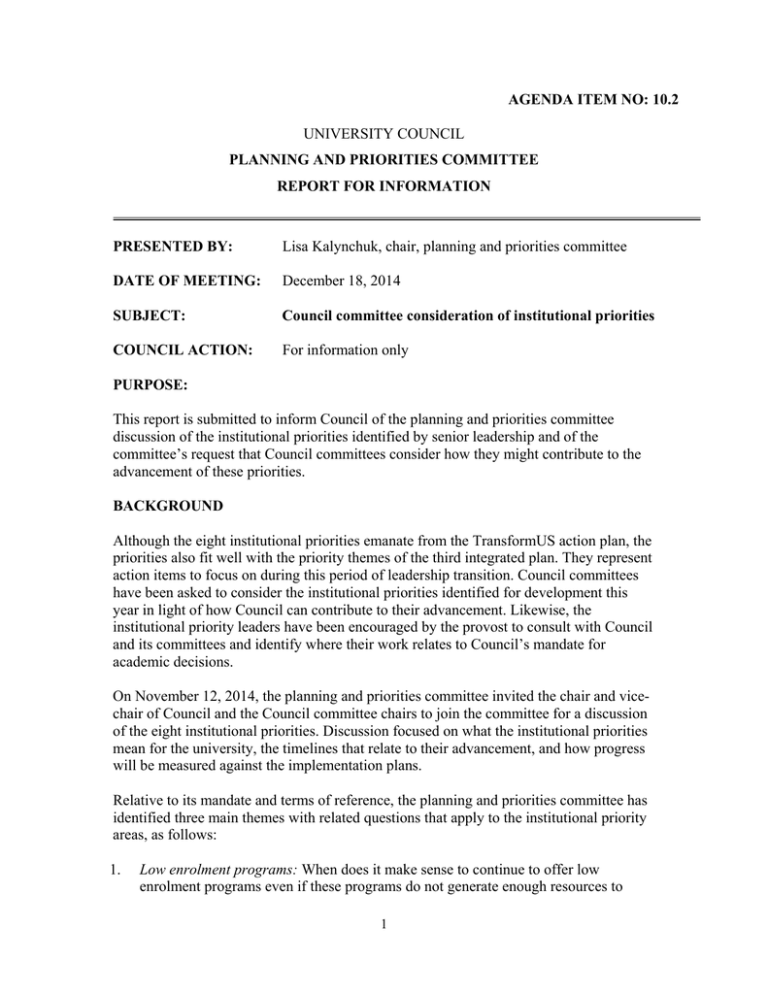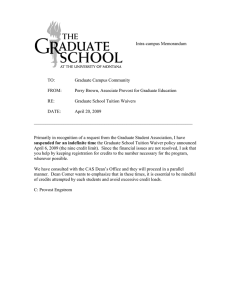UNIVERSITY COUNCIL Lisa Kalynchuk, chair, planning and priorities committee
advertisement

AGENDA ITEM NO: 10.2 UNIVERSITY COUNCIL PLANNING AND PRIORITIES COMMITTEE REPORT FOR INFORMATION PRESENTED BY: Lisa Kalynchuk, chair, planning and priorities committee DATE OF MEETING: December 18, 2014 SUBJECT: Council committee consideration of institutional priorities COUNCIL ACTION: For information only PURPOSE: This report is submitted to inform Council of the planning and priorities committee discussion of the institutional priorities identified by senior leadership and of the committee’s request that Council committees consider how they might contribute to the advancement of these priorities. BACKGROUND Although the eight institutional priorities emanate from the TransformUS action plan, the priorities also fit well with the priority themes of the third integrated plan. They represent action items to focus on during this period of leadership transition. Council committees have been asked to consider the institutional priorities identified for development this year in light of how Council can contribute to their advancement. Likewise, the institutional priority leaders have been encouraged by the provost to consult with Council and its committees and identify where their work relates to Council’s mandate for academic decisions. On November 12, 2014, the planning and priorities committee invited the chair and vicechair of Council and the Council committee chairs to join the committee for a discussion of the eight institutional priorities. Discussion focused on what the institutional priorities mean for the university, the timelines that relate to their advancement, and how progress will be measured against the implementation plans. Relative to its mandate and terms of reference, the planning and priorities committee has identified three main themes with related questions that apply to the institutional priority areas, as follows: 1. Low enrolment programs: When does it make sense to continue to offer low enrolment programs even if these programs do not generate enough resources to 1 sustain themselves? 2. Prioritization of strategic areas: Given that prioritization is necessary, how can balance be achieved between a focus on areas of strategic importance versus other areas of activity that are important but do not fall within the defined strategic areas? 3. Shared services and support for faculty members teaching and research: How can the shared services approach to the provision of support services deliver the support that faculty members have identified they need to achieve their teaching and research mandates? FURTHER ACTION REQUIRED Committee chairs have been asked to seek input from their respective committees regarding the institutional priorities, and then rejoin the planning and priorities committee to have another discussion early in 2015, with the institutional priority leaders in attendance. The planning and priorities committee will continue to inform Council of its discussion of the institutional priorities and of any broader themes that emerge from its discussion across Council committees. ATTACHMENTS: 1. List of institutional priorities and leaders 2 UniversityofSaskatchewan–PrioritiesforActionThisYear 1. Acceleratethedeliveryonourcommitmenttoaboriginalachievement. Representativeuniversityworkforce;studentsuccess;indigenousknowledgeincurricularofferings; signatureresearcharea;strengtheneduniversity‐communityrelationships;aligninginstitutional resourceswithourpriorities;coordinationandleadership. Leader:HeatherMagotiaux,vice‐president,AdvancementandCommunityEngagement 2. ContinuetherestructuringoftheCollegeofMedicine Rationalizingfinancialsupportandgovernanceofteaching,researchandclinicalservices;securing accreditationoftheundergraduatemedicalprogram;achievingsignificantimprovementin researchproductivity;supportsforfacultysuccess;becominganationalleaderinhealth innovation. Leader:PrestonSmith,deanofMedicine 3. Deliveronthepromiseofinter‐professionalhealtheducationandinter‐disciplinary healthresearch Sharedresourcesthroughtheacademichealthsciencesinfrastructure;inter‐professionalhealth education;interdisciplinaryhealthresearch;governanceandoperationsoftheCouncilofHealth ScienceDeans. Leader:KarenChad,vice‐presidentresearch 4.Advancethereorganizationandstrengtheningofgraduatestudiesandsupportfor graduatestudents. Choosebestalternativeforuniversity‐levelleadershipandoversightofgraduatestudies;strategies forincreasedfinancialsupportforgraduatestudents;integrationofstudentservices. Leader:AdamBaxter‐Jones,actingdean,CollegeofGraduateStudiesandResearch 5. Continuethecapitalprojectforthetransformationofourlibrarycollections,facilities, capitalandservices Strategicdevelopmentofcampuslibrarysystem;respondingtochangesinscholarly communicationsandpublishing;capturingopportunitiesprovidedbynewandemerging technologies;meetinggrowingdemandsfordifferentlyconfiguredlearningspaces;consolidating low‐useprintcollections. Leader:VickiWilliamson,dean,Library 6. Completethere‐organizationandrevitalizationofcentrallyorganizedteachingand learningactivitiesandfunctions Migrationoffunctionsandfunctionalemployeegroupstobettermeetorganizationalgoalsfor educationandresearch[CentreforContinuingandDistanceEducation(CCDE),MediaAccessand Production(eMAP)andtheUniversityLearningCentre(ULC)]. Leader:PattiMcDougall,vice‐provostteachingandlearning 7.Focusonthecreationofinter‐disciplinaryandcrosscollegeacademicprogramming. Captureopportunitiestomakebetteruseoffacultyresourcesandtoestablishcollaborations amongacademicunits. Leader:ToddiSteelman,executivedirector,SchoolofEnvironmentandSustainability 8.Alignouradministrativeservicesculturetosupportandfacilitateouracademicmission. Principlesandvaluesforthedesignanddeliveryofadministrativeservices. Leader:GregFowler,vice‐presidentfinanceandresources

